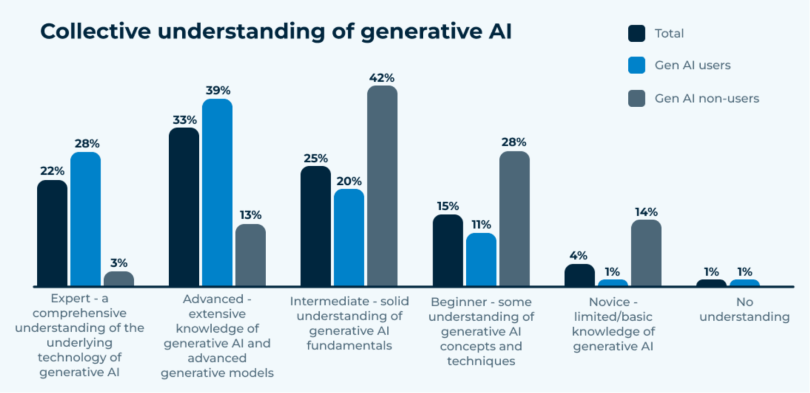Four pillars boards need to understand about generative AI
Generative AI is moving past being a buzzword to being woven into the fabric of business strategy and operations. It will undounbtedly lead to innovation, reconfiguration, and transformation across sectors. As it moves to the heart of business models and work structures, boards and executives must not only understand but adeptly navigate its complexities.
Responding to the results of a survey of board members, leading business thinker Tom Davenport asks Are Boards Kidding Themselves About Generative AI? In particular he points to their claimed degree of expertise in generative AI.

Source: Alteryx, What Boardroom Leaders Think About Generative AI
Given the scope of what boards need to comprehend around generative AI, there is clearly a gap between perceived knowledge and actual understanding. This is absolutely not just about understanding the technology, it is about having frameworks for considering the long-reaching and still-unfolding implications of generative AI.
Four Pillars for Boards to Understand
- Technical Foundations: While board members need not be AI engineers, a grasp of the foundational principles – the mechanics and limitations – is essential. They should understand the basics, such as the difference between generative models and analytic models, and the data and resources that power these AIs.
- Evolving AI Ecosystem: The AI landscape is dynamic. New startups, innovations, and shifts in industry standards mean that what’s relevant today might be outdated tomorrow. Boards should be cognizant of the changing players, platforms, and products.
- Practical Applications and Risks: AI isn’t a magic bullet. Identifying where it adds genuine value versus where it’s mere tech for tech’s sake is crucial. Alongside this, recognizing the pitfalls, from biased outputs to security concerns, is equally vital.
- Structural Implications: Beyond today’s use cases, boards should be visionary, anticipating how AI could transform industries, economies, and societies, uncover new business models, and likely redefine the nature of work.
In my engagements with various boards, it’s apparent that those who thrive are not those who deem themselves experts but those who are constantly curious. An adaptive mindset, rather than a fixed one, allows for agility in a world where AI’s path often zigzags rather than moving linearly.
The Proactive Role of Boards
Given the monumental influence of generative AI, it’s not enough for boards to be reactive. Instead, they must be proactive in shaping their organizations’ AI journey. This involves:
- Continuous learning: Embracing workshops, seminars, and collaborative sessions with AI specialists to bridge knowledge gaps.
- Establishing frameworks: Building considered frameworks for the pathways and relevance of generative AI, including governance, strategic priorities, work impact, including the use of scenario planning as a valuable tool.
- Ethical considerations: Establishing clear guidelines and protocols that ensure the ethical deployment of AI, addressing biases, transparency, and fairness.
As generative AI continues to progress, the onus lies on boards to be stewards of positive transformation. The intersection of AI and business contains vast potential and significant challenges. The future is deeply uncertain, but with informed, agile, and visionary leadership, boards can steer their organizations towards a promising AI-augmented future.

 Future of work at SwSX Sydney: beyond productivity and amplifying human pot...
Future of work at SwSX Sydney: beyond productivity and amplifying human pot... 
